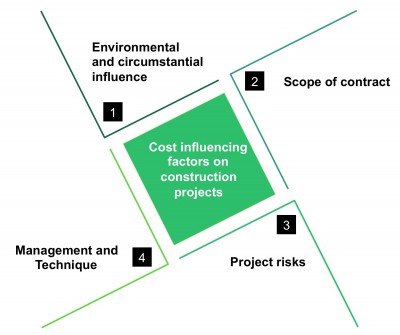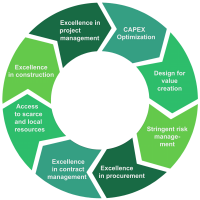Research on: Cost-drivers of construction sites.


There is more or less one way only to increase value of a firm, namely to increase cash flow through ROIC and growth.
A corporation’s future cash flows, however, are unknown and therefore fraught with risk. This becomes especially levered with respect to large CAPEX that are needed for asset heavy enterprises such as utilities, manufacturing and construction. Risk, however, is not to be used to refuse every opportunity. That said, it must be identified and shall match the desired economic benefits. Thus, the following paragraphs deal with potential influences and risks associated to construction endeavors in order to frame a construction project’s risks.
Large construction projects such as power generation plants and refining facilities have always been connected to compound challenges. With regard to technological changes, governance and regulation, globalized supply chains and competition, construction projects have become even more complex in recent years. Roughly, there are four major groups that largely influence a construction project’s success.
- Interest rate on bank loans and changes in mortgage rates
- The fluctuations in commodity price is too great
- The fluctuations in labor cost is too great
- Natural disaster and climate factor
- Political environment
- Geology, topography
- Gross domestic products (GDP)
- Level of demand on quality and project quality
- Modifications to the scope of construction and
- Clients requesting for modifications
- Scale of construction and user demand, structure type, project type, project location
- Contract types
- Modifications of project schedule
(ahead of schedule or stop in mid –construction) - Contract dispute (unclear drawings or guidelines/regulations)
- Clearly define the scope of project in the contract project scope specified in the bid
- The types of clients and the client’s way of dealing with key decisions
- Clients asking for the project to be finished ahead of schedule
- Protest and neighbor protests, tilted neighboring structure, labor protests
- Inadequate construction techniques
- Material shortage or supply delay
- Inadequate project listing
- Addition of new construction activities
- Addition on to the number of activities
- Stagnant project
- Policy change
- Delayed procurement
- Unexpected technical difficulties
- Disputes in opinions over the construction drawings
- The project scale is too big and the project itself too complex
- The client’s financial capability
- The subcontractors become bankrupt
- The gap between the construction plan and the reality is too great
- Occupational hazards
- Design modifications
- Project control meeting monitor and feedback
- The understanding of operational procedures during project management
- The client and engineer understand the difficulties in the actual operations
- Appropriate decision-making
- Procurement contract
- Regular budget update
- Material management
- Timetable for the materials to be delivered on site
- Project valuation does not match the collected payment
- Subcontractor’s valuation
- Personnel training
- Budget exceptions
- Labor attendance
- Cost control
- Time management
- The order of construction projects arrangement of construction progress
- Project manager’s capability
- Project manager’s leadership
- Project manager’s understanding of the operational procedure
- Project manager’s practical experience
- Project manager’s coordination capability
- Project manager’s risk management ability
- Whether the high-level management decentralizes the power
- Job site safety and health management
- Carry out supervision
- Whether the monitoring is implemented
- Project team (coordination capability and the understanding of operational procedure)
- Interactions among the project participants
- Coordination among the team members
- Coordination and mutual understanding of team
- Teamwork among high-level management and subcontractors
- Coordination between the project manager and the high-level management
- Conflicts that occur while the high-level management manages the project
- Support from the high-level management
- Coordination between the project manager and subcontractors
- Attitudes of the project manager and the subcontractors
- Subcontractors’ passive attitude toward project management
- The lack of experience for this type of project
- Subcontractors’ construction techniques
- Subcontractors’ financial difficulties
- Terminate the contractor’s contract and re-issue the contract
- Quality of the labor and engineering staff
- Construction personnel’s real-time decision-making
- Construction methods
- Construction machinery and equipment
- Replacement of construction equipment
- Knowledge and experience
- Bid rigging, competitive bidding, bid preparation period



Beyond traditional boundaries: Levoxx is your co-worker in transformation.
Each of our client’s assignments provides us with the unique possibility to produce added value together with our clients, shape standards, implement reasonably and enable long lasting impact.
Our solutions assist to look beyond conventional project management.
Levoxx’s Large Scale Project Approach (LLSPA) is deeply embedded in our working methodologies and comprises eight areas that drive a construction project’s success, deliver a project in time, on budget and at quality requirements.
We are committed to offering efficient effectiveness, permanently.
Our client services comprise an extraordinary composition of deep industry and functional expertise. We partner with global construction projects. Our services aim to deliver optimal planning, frictionless execution, transformation and peak performance operations.






